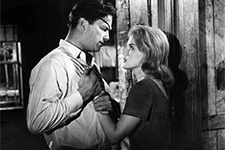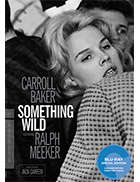Something Wild (1961)
|  Until it was revived about a decade ago, Jack Garfein’s Something Wild was an almost completely forgotten film—at best, a footnote in the history of American independent cinema and the effect of the fabled Actors Studio and “the Method” on ’50s and ’60s film style. It’s a shame that it fell off the radar for so long because it is an utterly fascinating film that doesn’t always work exactly, but is never anything less than completely engrossing, and if the end is both shocking and frustrating, it has earned the right to get under our skin and needle our assumptions. Garfein, who adapted the 1958 novel Mary Ann along with its writer, Alex Karmel, isn’t looking for easy or obvious or reassuring answers, but rather some semblance of that messy, unruly, sometimes infuriating thing we call “truth.” Whether or not the psychological underpinnings of the film’s uneasy ending ring true or false, as a whole the film is a daring and provocative look at identity, violence, and the need for human connection. (Quick note before I continue: If you have not yet seen the film, you should abandon here because it is definitely best viewed with the least amount of knowledge possible about its various and unexpected plot developments. Consider yourself warned.) Caroll Baker, herself a product of the Actors Studio who at the time was married to Garfein and was working to shed her association with the kittenish object of many men’s desire in Elia Kazan’s controversial Baby Doll (1956), plays Mary Ann Robinson, a 19-year-old college student who, in the film’s opening moments, is raped while walking home through the Bronx. Although depicted almost entirely in elliptical close-ups, the rape feels explicit, making for a particularly brutal entry point into the narrative as it establishes right away that Garfein is not pulling any punches (the Production Code was already wobbling and on its way out by the early ’60s, but I was surprised that they allowed such a direct depiction of sexual violence). When she comes to, Mary Ann pulls herself together, goes back to the home where she lives with her parents, wraps herself in a blanket, and begins the process of hiding from the world to cope with her trauma. For an extended period of time, we observe her without any dialogue as she bathes, methodically cuts up the clothing she was wearing when she was attacked, flushes the pieces down the toilet, and attempts to go about her life. But, life is no longer the same, something we glean from both Baker’s edgy performance—she vacillates between being like a zombie and being like an animal constantly on-guard—and from several expressionist sequences that convey in no uncertain terms her inner turmoil and fractured sense of self. At one point she enters a subway car—something she has probably done thousands of times—and is thrown into a panic attack when the car fills with people, their bodies pressing against hers and making her feel trapped and under assault. She eventually leaves her parents’ house without a word, taking up residence in a tenement in East Harlem and getting work at a five-and-dime. Yet, she is still unable to connect with anyone, whether it be the grinning floozy in the room next door (Jean Stapleton) or a friendly co-worker (Doris Roberts). She eventually feels so lost in life, so consumed by her trauma, that she finds herself walking along the Manhattan Bridge, starring down into the sparkling water, and leaning further and further over the railing. She is rescued—or at least stopped—from her suicide attempt by a mechanic named Mike (Ralph Meeker), who is a little rough around the edges, but seems like a decent enough person. He offers to let her rest in his basement apartment while he goes back to work. She is at first skeptical and, not surprisingly, skittish around Mike. But, there is something about him that she feels willing to trust, and she sleeps through the afternoon while he works and then accepts a homemade dinner from him that is sweetly awkward and seems like a potential breakthrough—the first step toward healing and reconciliation. But, it turns out to be quite the opposite, as Mike stumbles back to the apartment later that night, shockingly drunk and aggressive toward her, to which she responds by kicking him in the eye. With the only door locked and all the windows barred, Mary Ann must stay the night and await his awakening the next morning. Mary Ann thinks she is in the clear when he awakes the next morning with no memory of what happened, but then Mike does a very strange and unexpected thing: He quietly, almost gently refuses to let her leave. “I like the way you look here,” he tells her cryptically. The small, two-room basement apartment becomes her prison over the next several months, and Mike, the seemingly mild-mannered savior, reveals a sinister, psychologically warped side whose potential for violence gives the film’s entire second half a constant sense of unease and dread. Thus, what at first appears to be a drama about post-traumatic stress and isolation suddenly turns into a kind of horror film about literal entrapment. Mary Ann’s pleas to be released go unheard, and she must “play nice” with Mike in his forcibly contrived domestic scenario lest she incur his wrath, which is mostly verbal, but holds much in the way of physical threat. Why Mary Ann doesn’t make a stronger effort to escape is left unclear; she is left alone all day long, during which time she could surely plot something, even if it’s knocking him out with a frying pan while he sleeps (it’s not like he chains her to the bed at night or anything). One gets the sense that Garfein isn’t really interested in such plot mechanics, which would make the film a more routine thriller, but rather in that uneasy, queasy gray area where interpersonal relationships don’t always make immediate sense. We fear for Mary Ann and feel for the additional trauma she is enduring, yet Ralph Meeker’s sublime performance makes Mike oddly sympathetic, if only because we sense that he is also a tormented soul dealing with some unnamed trauma that has split him down the middle. And this is why the film’s ending—in which Mary Ann escapes when Mike leaves the door open after she rebukes his request that she marry him, spends the night wandering the city and sleeping in Central Park, and then returns to the apartment and embraces him, leading to a denouement in which we learn that she has married him and is pregnant—so difficult to swallow. On one level it doesn’t make any psychological sense, at least with the information we’re given; but, on another, more abstract level, it feels right because the film is primarily about upending our expectations and throwing us out of comfort zones, dramatic and otherwise. We want to see Mary Ann escape, we want to see her healed and find herself again, but not like this. Yet, that is exactly where Garfein leaves us, questioning everything and knowing precious little. The film’s backstory and production are almost as fascinating as the film itself. Garfein, who was born in Czechoslovakia and was the only member of his family to survive the Holocaust (he was shipped to Auschwitz at age 13 and made it through 11 camps before being liberated). After the war he went to the United States, where he studied acting under Lee Strasberg at the New School and was later accepted to the Actors Studio, where he studied as a director and actor under Elia Kazan and alongside James Dean, Marlon Brando, Ben Gazzara, and others. He made an auspicious leap from theatre to film with The Strange One (1957), an adaptation of Calder Willingham’s novel-turned-play End as a Man, which was notable for both introducing many of the Actors Studios thespians to the film world (including Gazzara) and for pushing boundaries in terms of criticizing masculinity and militarism and depicting homosexuality on-screen. Something Wild turned out to be his only other directorial effort, as its critical reception was mixed and its release through United Artists was extremely limited. Its title and advertising campaign made it seem salacious and thrilling, when it really had more in common with the European art cinema that was just beginning to cross the Atlantic into U.S. theaters (more than a few critics have suggested that, had it been released a few years later, it would have cemented Garfein’s reputation and assured him a long career). Garfein surrounded himself with an impressive roster of talent behind the screen, especially given the film’s low-budget nature. The percussive, sometimes discordant music is by Aaron Copland, his first dedicated film score since William Wyler’s The Heiress (1949), while the live-action opening credits, which establish the hustle and bustle of New York City, was created by the great graphic designer Saul Bass, who had already designed more than a dozen memorable opening credits sequences, including those for Hitchcock’s Vertigo (1958), North by Northwest (1959) and Psycho (1960) and Robert Wise’s West Side Story (1961). Garfein’s cinematographer was none other than the German émigré Eugen Schüfftan, who pioneered a number of visual effects tricks on Fritz Lang’s Metropolis (1927) and would win an Oscar that year for shooting Robert Rossen’s The Hustler (1961). Schüfftan’s stark black-and-white photography captures the intensity and anonymity of the big city (the location shooting all around New York City was a rarity at the time), and he makes Mike’s claustrophobic apartment an expressive prison of light and shadow. Given all those collaborators, it is surprising that Something Wild slipped through the cracks for as long as it did, but its place among American independent cinema is now fully assured, standing tall as a pioneering work that can still push buttons today.
Copyright © 2017 James Kendrick Thoughts? E-mail James Kendrick All images copyright © The Criterion Collection | |||||||||||||||||||||||||||||||||||
Overall Rating: 


 (3.5)
(3.5)


